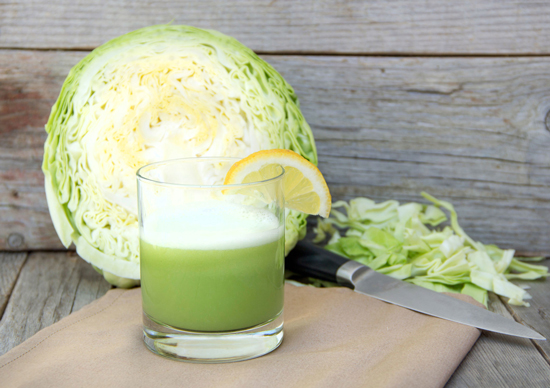Heal peptic ulcer in 10 days with vitamin U

In the late 1940s, Dr. Garnett Cheney, a professor of medicine at Stanford University School of Medicine, discovered the amazing ability of fresh cabbage juice to rapidly heal a peptic ulcer – and he attributed its powers to a substance he called “vitamin U”.
In the seven decades since then, modern research has identified powerful antioxidant, antibacterial and anti-inflammatory phytonutrients in cabbage juice, helping to confirm its value as an effective natural treatment for ulcers.
To learn more about the healing powers of “vitamin U” in fresh cabbage juice – and to put it to work for you – keep reading.
Cabbage juice outperformed standard medical peptic ulcer treatments by leaps and bounds
Published in January of 1949, the original study was titled Rapid Healing of Peptic Ulcers in Patients Receiving Fresh Cabbage Juice. Dr. Cheney reported that 13 patients with peptic ulcers who were given a liter of cabbage juice a day experienced rapid relief of their painful symptoms – without any other treatment.
Even more significantly, their ulcer craters healed completely within 7 to 10 days – a vast improvement over the 37 to 42 days of conventional ulcer treatment.
Surprisingly, the study received little attention from the medical community. (Or maybe it’s not so surprising, given conventional medicine’s longstanding reluctance to recognize natural therapies)!
In a second study, published in California Medicine in October of 1952, Dr. Cheney reported that 100 patients with uncomplicated peptic ulcers were treated successfully and rapidly with raw cabbage juice. As with the first study, ulcer crater healing time was shorter than in cases in which standard diet and drug therapies were used.
In 1956, Dr. Cheney published a third study – with identical results.
Today, fortunately, a growing number of professionals in both conventional and holistic medicine recognize the value of cabbage juice as a treatment for ulcers. Meanwhile, research is helping scientists understand the nuts and bolts of cabbage’s therapeutic powers.
Cabbage’s constituents are custom designed to soothe and heal the stomach
According to researchers, a pair of essential amino acids – glutamine and methionine – are key to the healing powers of cabbage.
Dr. Cheney’s mysterious “vitamin U” (the “U” stands for “ulcer”) is generally considered to be methionine S-methyl sulfonium, or MMS. Also known as S-methyl methionine, MMS stimulates the formation of mucus and works as a powerful antioxidant. Studies have shown that MMS supports normal healing in the stomach after exposure to NSAIDs.
Other constituents may play a part as well.
The amino acid L-glutamine is believed to be superior to commercial medications as an antacid, while a compound called gefarnate has been shown to have a protective effect on stomach lining.
Dr. James Heffley, Ph.D., past president and editor-in-chief of the Journal of Applied Nutrition, theorized that cabbage’s “magic ingredient” could be allantoin. A compound also found in comfrey root, allantoin has long been used in folk medicine for stomach ailments.
Dr. Heffley also favored “the teamwork concept” – wherein several antioxidants in a food enhance each other’s benefits synergistically – to explain cabbage’s stomach-soothing properties.
Cabbage juice helps to control the H. pylori bacteria that causes ulcers
Significantly, cabbage is also rich in glucosinolates, which convert to anti-inflammatory isothiocyanates. These compounds can help to suppress H. pylori bacteria – now acknowledged by doctors as a primary cause of most ulcers (the other is NSAIDs – nonsteroidal anti-inflammatory drugs such as aspirin, naproxen and ibuprofen).
H. pylori is an extremely common bacteria that infects up to 40 percent of the population. Often, it is asymptomatic and causes no problems, but in some individuals it penetrates the stomach lining and causes peptic ulcers.
Common ulcer symptoms can include burning stomach pain, heartburn, bloating, belching and nausea. More severe symptoms – which can indicate serious and even life-threatening ulcer complications – are vomiting (or vomiting blood), faintness, and black, tarry stools. Seek medical care immediately if you experience these.
Note: it is very possible to have an ulcer and not know it. Mayo Clinic reports that close to 75 percent of people with peptic ulcers don’t have symptoms.
How to take cabbage juice for an ulcer?
Naturally, you should first see a knowledgeable integrative physician for diagnosis and treatment if you suspect you have an ulcer – and to determine if fresh cabbage juice is right for you.
As for using cabbage juice – it couldn’t be much simpler. Most natural health experts advise taking the fresh juice of one-half to one whole head of raw cabbage several times a day before meals. (Many also recommend cabbage juice to treat IBS, gastritis and acid reflux).
If the taste of cabbage juice is unpalatable, you can add flavor and color with carrots, celery and broccoli.
For those who find the taste of the juice to be a deal-breaker, cabbage supplements are available in tablet form. In addition to containing “vitamin U complex” in the form of DL-methionine-methylsulfonium chloride, some supplements may also contain other ingredients – such as vitamin A and gamma oryzanol from rice bran oil – to potentiate the antioxidant effects.
To sum up: cabbage juice normalizes gastric and intestinal functioning, detoxifies the stomach, kills pathogens, causes rapid relief of ulcer pain and promotes healing in record time – quite a resume for the juice of a humble vegetable. Although the use of this natural remedy dates way back in time – cabbage juice can bring up-to-the-minute relief.
yogaesoteric
December 1, 2018
Also available in:
 Français
Français
